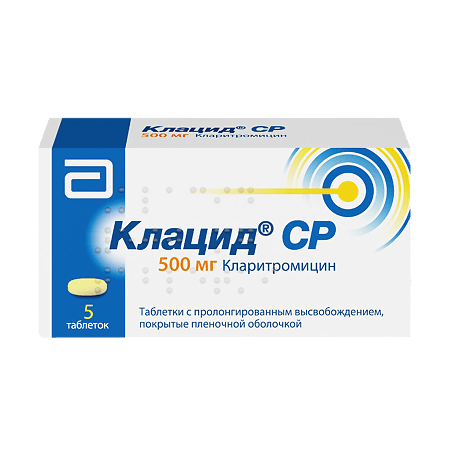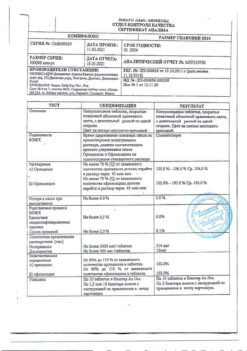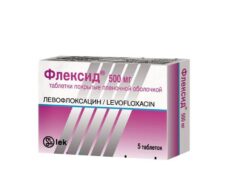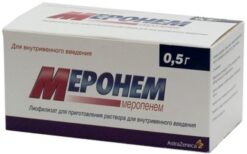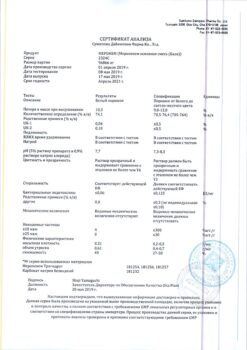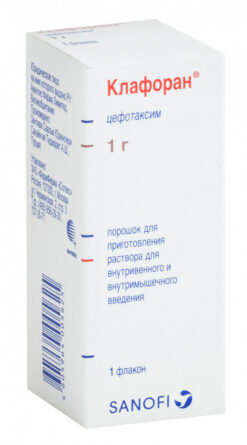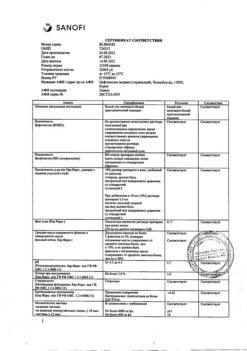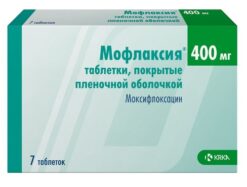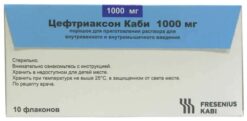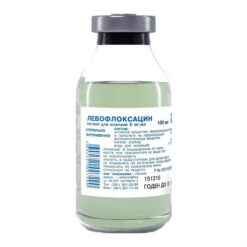No products in the cart.
Clacid SR, 500 mg 5 pcs
€16.37 €13.64
Description
Pharmacodynamics
Clarithromycin is a semi-synthetic antibiotic of macrolide group and has antibacterial effect by interacting with 50S ribosomal subunit and inhibiting protein synthesis of bacteria sensitive to it.
The sustained release tablets have a homogeneous base that allows prolonged release of the active ingredient as it passes through the gastrointestinal tract.
Clarithromycin is highly effective in vitro against both standard laboratory strains of bacteria and those isolated from patients in clinical practice. It is highly active against a wide range of aerobic and anaerobic, Gram-positive and Gram-negative microorganisms. The MAC of clarithromycin for most pathogens is lower than that of erythromycin.
In in vitro studies, clarithromycin has been shown to be highly active against Legionella pneumophila, Mycoplasma pneumoniae, but Enterobacteriaceae, Pseudomonas spp. and other non-lactose-fermenting Gram-negative microorganisms are not susceptible to clarithromycin.
The activity of clarithromycin against most strains of the following microorganisms has been proven both in vitro and in clinical practice for the diseases listed under “Indications”.
Aerobic gram-positive microorganisms – Staphylococcus aureus, Streptococcus pneumoniae, Streptococcus pyogenes; aerobic gram-negative microorganisms – Haemophilus influenzae, Haemophilus parainfluenzae, Moraxella catarrhalis, Legionella pneumophila; other microorganisms – Mycoplasma pneumoniae, Chlamydia pneumoniae; mycobacteria – Mycobacterium avium complex (MAC) – a complex including Mycobacterium avium, Mycobacterium intracellulare.
Beta-lactamases do not affect the activity of clarithromycin.
Clarithromycin in vitro is active against most strains of the microorganisms listed below:
– aerobic gram-positive microorganisms – Streptococcus agalactiae; Streptococcus spp. group C, F, G; Streptococcus spp. Viridans group; Listeria monocytogenes;
– aerobic Gram-negative microorganisms – Bordetella pertussis; Pasteurella multocida; Neisseria gonorrhoeae;
– anaerobic gram-positive microorganisms – Clostridium perfringens; Peptococcus niger; Propionibacterium acnes;
– anaerobic gram-negative microorganisms – Bacteroides melaninogenicus;
Spirochaetes – Borrelia burgdorferi; Treponema pallidum;
– Mycobacteria – Mycobacterium leprae, Mycobacterium kansasii, Mycobacterium chelonae, Mycobacterium fortuitum;
– Campylobacter – Campylobacter jejuni.
The main metabolite of clarithromycin in humans is microbiologically active metabolite 14(R)-hydroxy-clarithromycin (14-OH-clarithromycin), which is twice as active against Haemophilus influenzae (H. influenzae) as the parent compound. The parent compound (clarithromycin) and its metabolite in combination can have both additive and synergistic effects on H. influenzae in vitro and in vivo, depending on the bacterial strain.
Pharmacokinetics
Clarithromycin is metabolized in the liver cytochrome P450 3A (CYP3A) system. Absolute bioavailability is about 50%. No cumulation was found when taking the drug multiple times; the character of metabolism in human body was not changed.
In vitro
In vitro studies showed that on average about 70% of clarithromycin binds to human serum proteins at drug concentrations of 0.45-4.5 µg/ml. When the concentration was increased to 45.0 µg/ml, clarithromycin binding decreased to 41%, which may indicate saturation of the binding centers. This phenomenon was observed only at drug concentrations significantly higher than the therapeutic ones.
Healthy volunteers
In patients who received 500 mg of Clacid® SR once daily, Cmax of clarithromycin and 14-OH-clarithromycin – in plasma was 1.3 and 0.48 µg/ml, respectively. T1/2 of the original drug and metabolite were 5.3 and 7.7 h, respectively. At a single dose of Clacid®CP 1000 mg (2 times 500 mg) the Cmax of clarithromycin and its hydroxylated metabolite was 2.4 and 0.67 µg/ml, respectively. The T1/2 of clarithromycin when administered at a dose of 1000 mg was 5.8 h, whereas the same figure for 14-OH-clarithromycin was 8.9 h. Tmax for both 500 mg and 1000 mg was approximately 6 h. The Cmax of 14-OH-clarithromycin did not increase in proportion to the clarithromycin dose, while the T1/2 of both clarithromycin and its hydroxylated metabolite tended to increase with increasing dose. This nonlinear pharmacokinetics of clarithromycin combined with decreased formation of 14-hydroxylated and N-demethylated products at high doses indicates a nonlinear metabolism of clarithromycin that becomes more pronounced at higher doses.
The kidneys excrete approximately 40% of the intake of clarithromycin. The intestine excretes approximately 30%.
Patients taking clarithromycin as indicated
Clarithromycin and its 14-OH metabolite readily penetrate tissues and body fluids. Limited data from trials with a small number of patients suggest that the concentration of clarithromycin in cerebrospinal fluid when administered orally is negligible. Tissue concentrations are usually several times higher than serum concentrations.
Hepatic disorders
In a comparative study it has been shown that no dosage adjustment is required in patients with preserved renal function in patients with moderate to severe hepatic impairment.
Kidney disease
In people with renal impairment, plasma concentrations, T1/2, Cmax and Cmin of clarithromycin and its 14-OH metabolite were higher than in those with normal renal function. In patients with impaired renal function, the AUC was greater and the elimination constant and renal excretion was less. The degree of these differences correlated with the severity of renal disease: the more severe the renal impairment, the greater the differences.
The elderly
The elderly have higher plasma levels of clarithromycin and its 14-OH metabolite and slower excretion compared to the young. However, the main influence on the pharmacokinetic parameters of clarithromycin is renal function, not age.
Indications
Indications
Infectious and inflammatory diseases caused by microorganisms sensitive to the drug:
lower respiratory tract infections (such as bronchitis, pneumonia);
infections of the upper respiratory tract and ENT organs (such as pharyngitis, sinusitis);
infections of the skin and soft tissues (such as folliculitis, inflammation of the subcutaneous tissue, erysipelas).
Pharmacological effect
Pharmacological effect
Pharmacological action – antibacterial, bacteriostatic.
Pharmacodynamics
Clarithromycin is a semisynthetic antibiotic of the macrolide group and has an antibacterial effect by interacting with the 50S ribosomal subunit and inhibiting the protein synthesis of bacteria sensitive to it.
Extended-release tablets have a homogeneous base, which provides prolonged release of the active substance as it passes through the gastrointestinal tract.
Clarithromycin is highly effective in vitro against both standard laboratory strains of bacteria and those isolated from patients during clinical practice. It exhibits high activity against a wide range of aerobic and anaerobic, gram-positive and gram-negative microorganisms. The MIC of clarithromycin for most pathogens is less than the MIC of erythromycin.
In vitro studies have shown that clarithromycin is highly active against Legionella pneumophila, Mycoplasma pneumoniae, but Enterobacteriaceae, Pseudomonas spp. and other non-lactose-fermenting gram-negative microorganisms are immune to the action of clarithromycin.
The activity of clarithromycin against most strains of the microorganisms listed below has been proven both in vitro and in clinical practice for the diseases listed in the “Indications” section.
Aerobic gram-positive microorganisms – Staphylococcus aureus, Streptococcus pneumoniae, Streptococcus pyogenes; aerobic gram-negative microorganisms – Haemophilus influenzae, Haemophilus parainfluenzae, Moraxella catarrhalis, Legionella pneumophila; other microorganisms – Mycoplasma pneumoniae, Chlamydia pneumoniae; mycobacteria – Mycobacterium avium complex (MAC) – a complex including Mycobacterium avium, Mycobacterium intracellulare.
Beta-lactamases do not affect the activity of clarithromycin.
Clarithromycin is active in vitro against most strains of the following microorganisms:
– aerobic gram-positive microorganisms – Streptococcus agalactiae; Streptococcus spp. groups C, F, G; Streptococcus spp. Viridans groups; Listeria monocytogenes;
– aerobic gram-negative microorganisms – Bordetella pertussis; Pasteurella multocida; Neisseria gonorrhoeae;
– anaerobic gram-positive microorganisms – Clostridium perfringens; Peptococcus niger; Propionibacterium acnes;
– anaerobic gram-negative microorganisms – Bacteroides melaninogenicus;
– spirochetes – Borrelia burgdorferi; Treponema pallidum;
– mycobacteria – Mycobacterium leprae, Mycobacterium kansasii, Mycobacterium chelonae, Mycobacterium fortuitum;
– Campylobacter – Campylobacter jejuni.
The main metabolite of clarithromycin in the human body is the microbiologically active metabolite 14(R)-hydroxy-clarithromycin (14-OH-clarithromycin), which is twice as active against Haemophilus influenzae (H. influenzae) as the parent compound. The parent compound (clarithromycin) and its metabolite, when combined, may have either additive or synergistic effects on H. influenzae in vitro and in vivo, depending on the strain of the bacterium.
Pharmacokinetics
Clarithromycin is metabolized by the cytochrome P450 3A (CYP3A) system of the liver. Absolute bioavailability is about 50%. With repeated administration of the drug, no accumulation was detected; the nature of metabolism in the human body did not change.
In vitro
In vitro studies have shown that, on average, about 70% of clarithromycin is bound to human serum proteins at drug concentrations of 0.45–4.5 μg/ml. When the concentration was increased to 45.0 μg/ml, clarithromycin binding decreased to 41%, which may indicate saturation of binding sites. This phenomenon was observed only at drug concentrations significantly higher than therapeutic levels.
Healthy Volunteers
In patients taking 500 mg of the drug Klacid® SR 1 time per day, the Cmax of clarithromycin and 14-OH-clarithromycin in the blood plasma was 1.3 and 0.48 μg/ml, respectively. T1/2 of the parent drug and metabolite were 5.3 and 7.7 hours, respectively. When taking a single dose of Klacid®SR 1000 mg (2 times 500 mg), the Cmax of clarithromycin and its hydroxylated metabolite reached 2.4 and 0.67 μg/ml, respectively. T1/2 of clarithromycin when taken at a dose of 1000 mg was 5.8 hours, while the same figure for 14-OH-clarithromycin was 8.9 hours. Tmax when taking both 500 mg and 1000 mg was approximately 6 hours. Cmax of 14-OH-clarithromycin did not increase in proportion to the dose of clarithromycin, while T1/2 did clarithromycin and its hydroxylated metabolite tended to increase with increasing dose. This nonlinear pharmacokinetics of clarithromycin, coupled with a decrease in the formation of 14-hydroxylated and N-demethylated products at high dosages, indicates a nonlinear metabolism of clarithromycin, which becomes more pronounced at high dosages.
Approximately 40% of ingested clarithromycin is excreted by the kidneys. Approximately 30% is excreted by the intestines.
Patients taking clarithromycin for indications
Clarithromycin and its 14-OH metabolite quickly penetrate into body tissues and fluids. Limited data from trials involving small numbers of patients suggest that oral cerebrospinal fluid concentrations of clarithromycin are negligible. Concentrations in tissues are usually several times higher than in serum.
Liver diseases
A comparative study showed that if renal function was preserved in patients with moderate to severe impairment of hepatic function, no dosage adjustment was required.
Kidney diseases
In people with kidney disease, plasma concentrations, T1/2, Cmax and Cmin of clarithromycin and its 14-OH metabolite were higher than in people with normal renal function. In patients with impaired renal function, the AUC was higher, and the elimination constant and renal excretion were lower. The extent of these differences correlated with the severity of kidney disease: the more severe the renal dysfunction, the greater the differences.
Elderly people
In elderly people, plasma levels of clarithromycin and its 14-OH metabolite are higher and elimination is slower compared to young people. However, the main influence on the pharmacokinetic parameters of clarithromycin is renal function, not age.
Special instructions
Special instructions
Most strains of staphylococci resistant to methicillin and oxacillin are resistant to clarithromycin.
Long-term use of clarithromycin, like other antibiotics, can provoke colonization with an increase in the number of resistant bacteria and fungi. If a secondary infection occurs, adequate therapy should be prescribed.
When treated with almost all antibacterial agents, cases of pseudomembranous colitis have been described, the severity of which can vary from mild to life-threatening. One of the symptoms of pseudomembranous colitis is diarrhea caused by Clostridium difficile. Therefore, when diarrhea occurs after prescribing antibacterial agents, the possibility of such a disease should be taken into account.
After a course of antibiotic therapy, careful medical monitoring of the patient is necessary. Cases of the development of pseudomembranous colitis 2 months after taking antibiotics have been described.
It is possible to develop cross-resistance to clarithromycin and other macrolide antibiotics, as well as lincomycin and clindamycin.
In the presence of chronic liver diseases, it is necessary to regularly monitor serum enzymes.
In case of co-administration with warfarin or other indirect anticoagulants, PT must be monitored.
Active ingredient
Active ingredient
Clarithromycin
Composition
Composition
1 tab. contains:
Active substances:
clarithromycin 500 mg;
Excipients:
anhydrous citric acid – 128 mg,
sodium alginate – 120 mg,
sodium calcium alginate – 15 mg,
lactose monohydrate – 115 mg,
povidone K30 – 30 mg,
talc – 30 mg,
stearic acid – 21 mg,
magnesium stearate – 10 mg.
Film shell composition: hypromellose – 9.81 mg, macrogol 400 – 3.27 mg, macrogol 8000 – 3.27 mg, titanium dioxide – 1.64 mg, yellow dye (quinoline yellow) – 1.23 mg, sorbic acid – 0.16 mg.
Pregnancy
Pregnancy
The safety of clarithromycin in pregnant and lactating women has not been studied.
Use during pregnancy (especially in the first trimester) is possible only if the potential benefit to the mother outweighs the potential risk to the fetus and/or there is no safer therapy with alternative drugs.
If pregnancy occurs while using the drug, the patient should be warned about the possible risks to the fetus.
Clarithromycin is known to be excreted in breast milk. During lactation, the issue of stopping breastfeeding should be decided.
Contraindications
Contraindications
hypersensitivity to the components of the drug and other macrolides;
severe renal failure (creatinine Cl less than 30 ml/min);
simultaneous use of clarithromycin with the following drugs: astemizole, cisapride, pimozide, terfenadine, ergotamine, dihydroergotamine (see “Interaction”);
simultaneous use with the following drugs: alprazolam, midazolam, triazolam (oral dosage forms);
children under 18 years of age (efficacy and safety have not been established);
porphyria;
lactose intolerance, lactase deficiency, glucose-galactose malabsorption.
With caution: impaired liver and kidney function; myasthenia gravis (possibly increased symptoms); simultaneous use with drugs that are metabolized by the liver (see “Interaction”).
Side Effects
Side Effects
Side effects are presented depending on the effect on organs and organ systems. For cases indicating frequency, consider: often >1%, <10%; rarely <1%, incl. individual cases.
From the cardiovascular system: rarely – ventricular tachycardia, incl. pirouette type, ventricular flutter and fibrillation, increased QT interval on the ECG.
From the digestive system: often – dyspepsia, nausea, abdominal pain, vomiting, diarrhea, gastralgia, acute pancreatitis, glossitis, stomatitis, candidiasis of the oral mucosa, discoloration of the tongue and teeth, pseudomembranous enterocolitis. Liver dysfunction, incl. often – increased activity of liver enzymes, hepatocellular and cholestatic hepatitis, cholestatic jaundice. In very rare cases, fatal liver failure has been reported, mainly due to severe concomitant diseases and/or concomitant drug therapy.
From the nervous system: headaches (often); dizziness, anxiety, insomnia, dream disturbances (“nightmare” dreams), ringing in the ears, depersonalization, hallucinations, convulsions, psychotic disorders, confusion, disorientation, depression.
From the musculoskeletal system: myalgia.
From the urinary system: interstitial nephritis.
From the senses: often – distortion or loss of taste; deafness, cases of changes in sense of smell.
Allergic reactions: anaphylactic reactions, Stevens-Johnson syndrome, toxic epidermal necrolysis, urticaria, skin flushing, itching, rash.
Changes in laboratory parameters: leukopenia, thrombocytopenia, increased creatinine in the blood, hypoglycemia – rarely (including when taking hypoglycemic drugs simultaneously).
Interaction
Interaction
The use of the following drugs with clarithromycin is contraindicated due to the potential for serious side effects.
Cisapride and pimozide
When used together, it is possible to increase the concentration of cisapride, increase the QT interval, and the appearance of cardiac arrhythmias, including ventricular tachycardia, ventricular fibrillation, and torsade de pointes.
Terfenadine and astemizole
When used together, it is possible to increase the concentration of terfenadine/astemizole in the blood, increase the QT interval, cause cardiac arrhythmias, ventricular tachycardia, ventricular fibrillation and pirouette-type tachycardia.
Ergotamine/dihydroergotamine
When used together, the following effects associated with acute poisoning with drugs of the ergotamine group are possible: vascular spasm, ischemia of the limbs and other tissues, including the central nervous system.
Effect of other drugs on clarithromycin
The following drugs have a proven or suspected effect on clarithromycin concentrations; if they are co-administered with clarithromycin, dosage adjustments or switching to alternative treatment may be required.
Efavirenz, nevirapine, rifampicin, rifabutin and rifapentine
Strong inducers of the cytochrome P450 system, such as efavirenz, nevirapine, rifampicin, rifabutin and rifapentine, can accelerate the metabolism of clarithromycin and thus reduce the plasma level of clarithromycin, weaken the therapeutic effect, and at the same time increase the level of 14-OH-clarithromycin, a metabolite that is also microbiologically active.
Fluconazole
Coadministration of fluconazole 200 mg daily and clarithromycin 500 mg twice daily in 21 healthy volunteers resulted in clarithromycin trough mean Css and AUC increases of 33% and 18%, respectively.
However, co-administration did not significantly affect the average Css of the active metabolite 14-OH-clarithromycin. No dose adjustment of clarithromycin is required when taking fluconazole concomitantly.
Ritonavir
A pharmacokinetic study showed that co-administration of ritonavir 200 mg every eight hours and clarithromycin 500 mg every 12 hours resulted in a marked suppression of the metabolism of clarithromycin. When coadministered with ritonavir, clarithromycin Cmax increased by 31%, Cmin increased by 182%, and AUC increased by 77%. Complete inhibition of 14-OH-clarithromycin formation was noted.
Due to the wide therapeutic index, dosage reduction is not required in patients with normal renal function. In patients with renal failure, it is advisable to consider the following dose adjustment options: if creatinine Cl is 30–60 ml/min, the dose of clarithromycin should be reduced by 50% (no more than one Klacid® SR tablet per day). Patients with severe renal failure (Cl creatinine < 30 ml/min) should not take Klacida® SR due to the impossibility of adequate dose adjustment (reduction) (see “Contraindications”). Clarithromycin regular release tablets can be used in these patient groups. Ritonavir should not be co-administered with clarithromycin in doses exceeding 1 g/day.
Effect of clarithromycin on other drugs
Antiarrhythmic drugs (quinidine and disopyramide)
Torsade de pointes may occur when clarithromycin is co-administered with quinidine or disopyramide. When clarithromycin is coadministered with these drugs, ECG monitoring should be performed regularly to monitor for QT interval prolongation, and serum concentrations of these drugs should also be monitored.
CYP3A-mediated interactions
Co-administration of clarithromycin, which is known to inhibit CYP3A isoenzymes, and drugs primarily metabolized by CYP3A isoenzymes, may be associated with a mutual increase in their concentrations, which may increase or prolong both therapeutic and side effects. Clarithromycin should be administered with caution to patients receiving drugs that are substrates of the CYP3A enzyme, especially if the CYP3A substrate has a narrow therapeutic range (eg, carbamazepine) and/or is extensively metabolized by this enzyme. If necessary, the dose of the drug taken together with Klacid® SR should be adjusted, and the joint use of certain drugs should be excluded (see “Contraindications”). Also, whenever possible, serum levels of drugs primarily metabolized by CYP3A should be monitored. The following drugs/classes are metabolized by the same CYP3A isoenzyme as clarithromycin: alprazolam, astemizole, carbamazepine, cilostazol, cisapride, cyclosporine, disopyramide, ergot alkaloids, lovastatin, methylprednisolone, midazolam, omeprazole, oral anticoagulants (eg warfarin), pimozide, quinidine, rifabutin, sildenafil, simvastatin, tacrolimus, terfenadine, triazolam and vinblastine. Drugs that interact similarly through other isoenzymes within the cytochrome P450 system include phenytoin, theophylline, and valproic acid.
HMG-CoA reductase inhibitors
Like other macrolides, clarithromycin increases concentrations of HMG-CoA reductase inhibitors (eg lovastatin and simvastatin). Rare cases of rhabdomyolysis have been reported in patients taking these drugs together.
Omeprazole
Clarithromycin (500 mg every 8 hours) was studied in healthy adult volunteers in combination with omeprazole (40 mg daily). When clarithromycin and omeprazole were co-administered, plasma Css of omeprazole were increased (Cmax, AUC0-24 and T1/2 increased by 30, 89 and 34%, respectively). The average pH value in the stomach over 24 hours was 5.2 when taking omeprazole alone and 5.7 when taking omeprazole together with clarithromycin.
Oral anticoagulants
The effect of oral anticoagulants may be enhanced. If patients are receiving clarithromycin and oral anticoagulants concomitantly, the PT should be carefully monitored.
Sildenafil, tadalafil and vardenafil
Each of these phosphodiesterase inhibitors is metabolized, at least in part, by CYP3A. However, CYP3A may be inhibited in the presence of clarithromycin. Co-administration of clarithromycin with sildenafil, tadalafil or vardenafil may lead to increased phosphodiesterase inhibitory effects. When prescribing these drugs together, consider reducing the dose of sildenafil, tadalafil and vardenafil.
Theophylline, carbamazepine
It is possible to increase the concentration of theophylline or carbamazepine in the systemic circulation.
Tolterodine
The primary metabolism of tolterodine occurs through cytochrome P450 isoform 2D6 (CYP2D6). However, in part of the population lacking the CYP2D6 isoenzyme, metabolism occurs through CYP3A. In this population, inhibition of CYP3A results in significantly higher serum concentrations of tolterodine. In populations that are poor metabolizers via CYP2D6, a reduction in the dose of tolterodine may be necessary in the presence of CYP3A inhibitors such as clarithromycin.
Triazolobenzodiazepines (eg alprazolam, midazolam, triazolam)
When midazolam and clarithromycin (500 mg 2 times a day) were co-administered, an increase in midazolam AUC was observed: 2.7 times after intravenous administration of midazolam and 7 times after oral administration. Concomitant oral administration of midazolam and clarithromycin should be avoided. If clarithromycin is co-administered with intravenous midazolam, the patient’s condition should be carefully monitored for possible dose adjustment. The same precautions should be applied to other benzodiazepines that are metabolized by CYP3A, including triazolam and alprazolam. For benzodiazepines whose elimination is not dependent on CYP3A (temazepam, nitrazepam, lorazepam), a clinically significant interaction with clarithromycin is unlikely.
When clarithromycin and triazolam are used together, CNS effects such as drowsiness and confusion are possible.
Interaction with other drugs
Colchicine
Colchicine is a substrate of both CYP3A and the drug efflux transport protein P-glycoprotein (P-gp). Clarithromycin and other macrolides are known to inhibit CYP3A and P-gp. When clarithromycin and colchicine are co-administered, inhibition of P-gp and/or CYP3A may result in an increased effect of colchicine. There have been post-marketing reports of cases of colchicine poisoning when taken concomitantly with clarithromycin, most often in elderly patients. Some of the reported cases occurred in patients suffering from kidney failure. Some cases were reported to be fatal.
Digoxin
Digoxin is thought to be a substrate for P-gp. Clarithromycin is known to inhibit P-gp. When clarithromycin and digoxin are co-administered, inhibition of P-gp by clarithromycin may result in increased effects of digoxin. Coadministration of digoxin and clarithromycin may also result in increased serum digoxin concentrations in patients, developing clinical symptoms of digoxin toxicity, including potentially fatal arrhythmias. Serum digoxin concentrations should be carefully monitored when clarithromycin and digoxin are coadministered.
Zidovudine
Concomitant use of clarithromycin regular-release oral tablets and zidovudine in adult HIV-infected patients may result in a decrease in the Css of zidovudine. Because clarithromycin interferes with the oral absorption of zidovudine, interactions can be largely avoided by titrating the dosage of clarithromycin and zidovudine. This type of interaction does not occur in HIV-infected children receiving clarithromycin suspension with zidovudine. Interaction studies between Klacid® SR and zidovudine have not been conducted.
Bidirectional drug interactions
Atazanavir
Clarithromycin and atazanavir are substrates and inhibitors of CYP3A. There is evidence of a bidirectional interaction between these drugs. Coadministration of clarithromycin (500 mg twice daily) and atazanavir (400 mg once daily, daily) may result in a 28% increase in atazanavir AUC, a twofold increase in clarithromycin AUC, and a 70% decrease in 14-OH-clarithromycin AUC. Due to the wide therapeutic range of clarithromycin, no dose reduction is required in patients with normal renal function. In patients with moderate renal impairment (Cl creatinine 30–60 ml/min), the dose of clarithromycin should be reduced by 50%. Clarithromycin in doses exceeding 1000 mg/day should not be co-administered with protease inhibitors.
Itraconazole
Clarithromycin and itraconazole are substrates and inhibitors of CYP3A. Clarithromycin may increase plasma levels of itraconazole, while itraconazole may increase clarithromycin levels. Patients taking itraconazole and clarithromycin concomitantly should be closely monitored for symptoms of increased or prolonged pharmacological effects of these drugs.
Saquinavir
Clarithromycin and saquinavir are substrates and inhibitors of CYP3A. Coadministration of clarithromycin (500 mg twice daily) and saquinavir (soft gelatin capsules, 1200 mg three times daily) may increase the AUC and Cmax of saquinavir by 177% and 187%, respectively, compared with saquinavir alone. The AUC and Cmax values of clarithromycin were approximately 40% higher than with clarithromycin. When these two drugs are administered together for a limited time at the doses/formulations indicated above, no dosage adjustment is required.
Results from drug interaction studies using saquinavir soft gelatin capsules may not be consistent with the effects observed with saquinavir hard gelatin capsules. The results of drug interaction studies with saquinavir alone may not correspond to the effects observed with saquinavir/ritonavir therapy. When taking saquinavir with ritonavir, the potential effect of ritonavir on clarithromycin should be considered.
Verapamil
When taken together with clarithromycin, arterial hypotension, bradyarrhythmia and lactic acidosis are possible.
Overdose
Overdose
Symptoms: Taking a large dose of clarithromycin may cause symptoms of gastrointestinal disorders. In one patient with a history of bipolar disorder, changes in mental status, paranoid behavior, hypokalemia, and hypoxemia were described after taking 8 g of clarithromycin.
Treatment: in case of overdose, symptomatic therapy should be carried out, including gastric lavage, aimed at maintaining the vital functions of the body. Hemodialysis and peritoneal dialysis do not have a significant effect on the level of clarithromycin in the serum, which is also typical for other macrolide drugs.
Storage conditions
Storage conditions
In a place protected from light, at a temperature of 15–30 °C
Shelf life
Shelf life
1 year
Manufacturer
Manufacturer
EbbVee S.r.L., Italy
Additional information
| Shelf life | 1 year |
|---|---|
| Conditions of storage | In a light-protected place at 15-30 °C |
| Manufacturer | AbbVi S.r.l., Italy |
| Medication form | sustained release tablets |
| Brand | AbbVi S.r.l. |
Related products
Buy Clacid SR, 500 mg 5 pcs with delivery to USA, UK, Europe and over 120 other countries.

